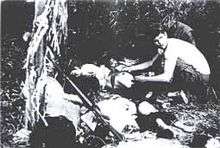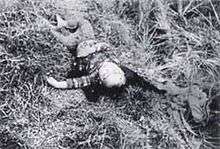Phong Nhị and Phong Nhất massacre
| Phong Nhị and Phong Nhất massacre | |
|---|---|
 U.S. Marines recovered victims' bodies in Phong Nhi and Phong Nhat village on 12 February 1968 | |
| Location | Phong Nhi village, Điện Bàn District of Quảng Nam Province, South Vietnam |
| Date | 12 February 1968 |
| Target | Phong Nhi villagers |
Attack type | Massacre |
| Deaths | 69–79[1] |
| Perpetrators |
|

The Phong Nhị and Phong Nhất massacre[4][5] (Korean: 퐁니·퐁넛 양민학살 사건, Vietnamese: Thảm sát Phong Nhất và Phong Nhị) was a massacre reported to have been conducted by the 2nd Marine Division of the South Korean Marine Corps on 12 February 1968 of unarmed citizens in Phong Nhị and Phong Nhất village, Điện Bàn District of Quảng Nam Province in South Vietnam.[6] The South Korean forces had been newly transferred from the area, in the wake of the Tet Offensive, with the village located in a densely populated region in and around Da Nang. Transferring Korean Marines to the populated Da Nang sector from a less populated sector was unpopular with ARVN and US Commanders and setting back pacification and relation-building efforts, due to the behaviour of Korean forces.[7]
Events
At the time the massacre occurred, the Phong Nhị villagers had had a close relationship with the U.S. Marines as it formed a part of the Combined Action Program and the village men were enlisted as South Vietnamese soldiers.[4]:32 As reported by members of CAP-2, the 2nd Marine Division had passed the CAP-2 team on their way out of the village "swung left and firing was heard throughout".[8] Just 30 minutes following this, the CAP-2 members attempted to contact the ROK 2nd Marine Division, without any success as ROK Commanders said ROK Marines were not in the area, and switched to the ROK-Command radio requesting to fire mortars at where the ROK forces were operating but permission was denied.[8] Neither the operation by the ROK Forces was approved by nor notified by the District Chief, but the ROK Executive Officer apologized and left "30 bags of rice" following the massacre.[8] The ROK Company was identified as having fired artillery at the village, having shot at the villages with small-arms fire, and having directly been within the vicinity at the time of the massacre. After the massacre, U.S. Marines and Army of the Republic of Vietnam (ARVN) soldiers reached the village later that day; they treated and transported the surviving villagers to nearby hospitals.[2][3]
In 1969, one of the victims' families made a petition to the President of South Vietnam Parliament for compensation.[9] The local South Vietnamese civilians were particularly disturbed that the massacre was perpetrated by ROK forces against villagers who had family members in ARVN forces.[10] Testimonies of survivors at Da Nang hospital,as well as the USMC patrol that had found the victims had identified ROK-forces as responsible with no Viet Cong in the vicinity.[8]
On 25 February, another massacre purportedly occurred in nearby Hà Mỹ village.
Report
Eye-witness testimony from both the members of the CAP-Program and survivors at the hospital prompted grounds for a war-crime investigation for investigation were done from CAP-Commanders and COMUSMACV, both making direct demands that ROK Commander Chae-Myungshin investigate. On 16 April 1968 the III MAF reported on the incident to Military Assistance Command, Vietnam (MACV). A total of five other hamlet massacres were investigated as well, at Hoang Chau hamlet, Phouc My, Thanh Phu and Hoa Phon.[8] On 29 April, MACV sent the report to the South Korean Vietnam Expeditionary Forces Commanding Officer Lieutenant general Chae Myung-shin (ko). On 4 June 1968, General Chae advised MACV that he had investigated the incident and stated that Viet Cong forces disguised in Korean-style camouflage uniforms in order to discredit the Korean forces.[8] Chae alleged that there were numerous cases in which the Viet Cong utilized the duckhunter pattern used by the South Korean marines to commit misdeeds in order to incite unpopular opinion allegedly supporting his claim with the testimony of an ARVN Sergeant.[8] This is despite contradictory testimony by survivors of these massacres, interviewed by US Army Personnel at Da Nang hospital as well as U.S. Armed Forces personnel who rescued the civilians, all of whom blame Korean Forces.[8] Furthermore Viet Cong secret reports discuss this massacre, clearly blaming the Korean forces for conducting this massacre and discussed reprisals to rally villagers to their cause and away from GVN/USMC pacification efforts.[10]
Aftermath

The massacres had negatively impacted ongoing pacification efforts in the region, and became widely known.[10] Transferring Korean Marines to the populated Da Nang sector of I Corps and I Field Force from an un-populated sector had set-back considerable effort in winning support and deteriorated relations with locals.[7] This massacre alongside the Hà My massacre and other ongoing massacres and atrocities had undermined continual efforts at pacification.[7] South Vietnamese and US commanders from the region had a negative appraisal of Koreans with General Rathvon M. Tompkins and General Robert E. Cushman Jr. being quite negative about the Koreans being transferred to the sector, as they were regarded as generally uncooperative and unwilling to engage in security while committing atrocities.[7] These atrocities were reported by ARVN/US commanders and sent down to Saigon.[7] Korean forces were transferred back to II Corps/II Field Force following this incident, and were relegated to guarding bases and minimising any offensive or combat actions.
On 11 November 2000, General Chae conceded that Chief of Staff of the United States Army General William Westmoreland demanded the investigation several times.[11] The South Korean commander still stated that the two villages were not in the route of the South Korean marines who patrolled the area and repeatedly maintained blame on the Viet Cong who allegedly wore the South Korean marine uniforms.[11]
The event had been prominently featured in the Korean media when it was broke by Ku Su-Jeong looking at Hanoi's archives around the time of relationship normalisation,[12] and Korean civic groups have called on apologies for this event from Korean leaders[13] alongside survivors of the massacre.[14] South Korean sculptors Kim Seo-kyung & Kim Eun-sung, two sculptors whom designed the comfort women Pieta statutes, have built a similar commemorative statute at the location of the massacre.[15]
See also
References
- ↑ Han Hong-gu, Sungkonghoe University professor. 미국의 관심은 '학살은폐 책임' 최초공개된 미국 비밀보고서의 의미… 정부는 참전군인의 명예를 위해서 진상조사에 나서라. Hankyoreh (in Korean). Retrieved 29 January 2011.
- 1 2 3 4 Go Gyeong-tae (24 January 2001). 특집 "그날의 주검을 어찌 잊으랴" 베트남전 종전 26돌, 퐁니·퐁넛촌의 참화를 전하는 사진을 들고 현장에 가다. Hankyoreh (in Korean). Retrieved 27 January 2011.
- 1 2 여기 한 충격적인 보고서가 있다 미국이 기록한 한국군의 베트남 학살 보고서 발견. OhmyNews (in Korean). Archived from the original on 6 March 2012. Retrieved 27 January 2011.
- 1 2 Kwon, Heonik. After the massacre: commemoration and consolation in Ha My and My Lai. University of California Press. p. 47. ISBN 978-0-520-24797-0.
- ↑ Kim Chang-seok (15 November 2000). 편견인가, 꿰뚫어 본 것인가 미군 정치고문 제임스 맥의 보고서 "쿠앙남성 주둔 한국군은 무능·부패·잔혹". Hankyoreh (in Korean). Retrieved 27 January 2011.
- ↑ Go Gyeong-tae. 잠자던 진실, 30년만에 깨어나다 "한국군은 베트남에서 무엇을 했는가"… 미국 국립문서보관소 비밀해제 보고서·사진 최초공개. Hankyoreh (in Korean). Retrieved 27 January 2011.
- 1 2 3 4 5 Shulimson, Jack (2015-11-06). U.S. Marines In Vietnam: The Defining Year, 1968. Pickle Partners Publishing. p. 1122. ISBN 9781786256331.
- 1 2 3 4 5 6 7 8 http://vietnamvoices.org/wp-content/uploads/2015/10/US-Army-IG_ROK-Marines_Report_1969.pdf
- ↑ Go Gyeong-tae (23 November 2000). "끝없이 벗겨지는 '제2의 밀라이'". Hankyoreh. Retrieved 25 July 2011.
- 1 2 3 Kwon, Heonik. "Anatomy of US and South Korean Massacres in the Vietnamese Year of the Monkey, 1968 | The Asia-Pacific Journal: Japan Focus". apjjf.org. Retrieved 2018-06-07.
- 1 2 Kim Chang-seok (15 November 2000). "한국군도 많이 당했다" 채명신 전 주월한국군총사령관 인터뷰… 남베트남군 사령관 만나 사과한 적도. Hankyoreh (in Korean). Retrieved 28 January 2011.
- ↑ "Reckoning with Korea's role in Vietnam War massacres". Korea JoongAng Daily. Retrieved 2018-06-15.
- ↑ Herald, The Korea (2017-11-09). "'Time to apologize for Korea's own war crimes in Vietnam'". Retrieved 2018-06-15.
- ↑ "[Newsmaker] Vietnam massacre victims demand Korean government's apology". Herald English. Retrieved 2018-06-15.
- ↑ "Sculptor to make symbol of Vietnam massacres". koreatimes. 2017-06-21. Retrieved 2017-06-22.
Further reading
- Armstrong, Charles (2001). Critical Asian Studies: America's Korea, Korea's Vietnam. 33. Routledge.
External links
| Wikimedia Commons has media related to Phong Nhi massacre. |
